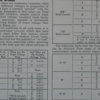On the 1033 transformer, there is a "U" = common terminal (or what I always thought was common), and then A, B, and C "Hot" terminals. On the unit's face plate is:
A-U = 5-16 volts
B-U = 0-11 volts
Using the black lever, one can vary the voltage using the above combos.
However, what does the C-U deliver? I tried a test and it seems to deliver instantaneous power upon moving the lever.
To make this confusing, the instructions state that A-B = 5 volts; B-C = 11 volts; and A-C = 16 volts. Does that infer that C is a common, but than I would've gotten a short when I connected C-U?
What am I missing in understanding this?








